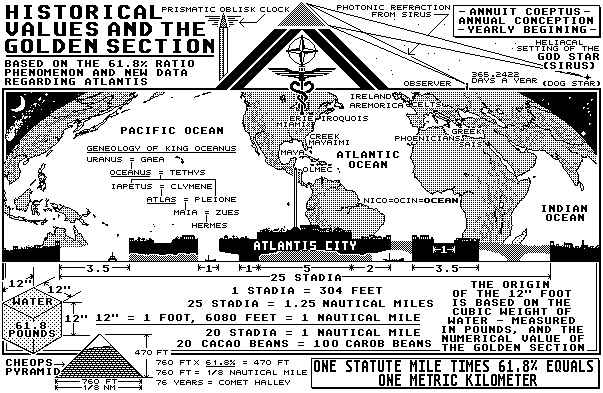
The value of the Golden Section Measurement.
The natural value of the Golden Section phenomenon and how it relates to our mesurement system should be taught in school more than it is now.

The value of the Golden Section Measurement.
The natural value of the Golden Section phenomenon and how it relates to our mesurement system should be taught in school more than it is now.
1/ To better understand the chronological measurements of how the Trans-Atlantean Solar Calendar came into being and why this lost time-scale represents one of the most important achievements in human history, we should examine and fully comprehend two major lessons in the field of mathematics.
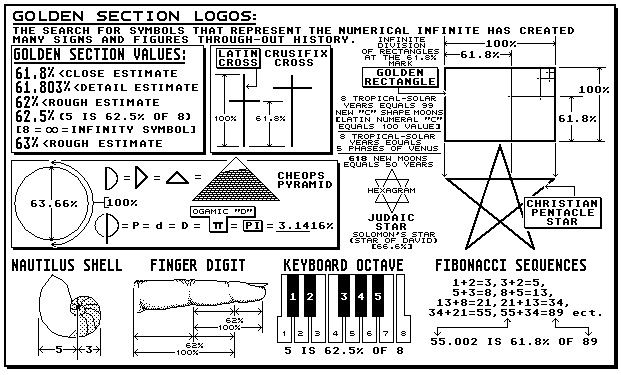
Golden Section Measurement Logos.
The Golden Section phenomenon is found throughout nature. Based on the finite concept of measuring infinite values, this mathematical measurement is graphically illustrated in many ways.
3/ There exists throughout nature an eternal mathematical phenomenon know as "The Golden Section" -- in which the decimal ratio value of 61.8% translates into a numerical percentage concept that represents a finite value for sectional measurements with infinite algorithmic proportions.
4/ In other words, "The Golden Section" ratio formula of 61.8% can be thought as a finite ratio concept which represents certain numerical and geometrical measurements in nature that have infinite proportional values -- for example: If the short side lines of a rectangle measured the ratio of 61.8% of its two long sides, it would be considered as a "Golden Rectangle" -- and if the longer sides of the rectangle were to be sectioned off to their 61.8% mark, then another "Golden Rectangle" would result from within the original "Golden Rectangle" -- which, in turn, could again be further sectioned off to the 61.8% mark over and over again, creating an "infinite amount" of smaller "Golden Rectangles".
5/ So the finite ratio value of 61.8% roughly represents a numerical concept that imitates or symbolises "infinity".
(An example of the 61.8% value concept in nature can be found by comparing the inside spiral proportional measurements of the Nautilus shell and seeing the infinite value measurement between its center and its outsides)
[The Golden Section ratio formula of 61.8% is a rounded number of an infinite mathematical value much like the numerical value of "pi".]
6/ Also known as the "Golden Mean" or the "Divine Proportion", the Golden Section ratio concept can also be found in the progressive layout of sequential numbers known as the "Fibonacci Sequences" -- in that the ratio value between progressive sequential numbers gets closer and closer to the 61.8% value, for example: 1,2,3,5,8,13,21,34,55,89,ect. -- 55.002 is 61.8% of 89.
(It is important to understand that since many early mathematicians did not possess the technical resources of realizing the minute measurable difference between 61.8% and a similar proportional value of 62.5%, in which the number "5" is 62.5% of the number "8", "The Golden Section" value of 61.8% and the 5/8 value of 62.5% may have both represented the same "infinite value")
7/ Trigonometry also uses this proportional ratio formula, for example: The lines of a five-star pentacle intersect at the 61.8% mark of the cord.
(There exists presently over fifty international flags that display the five-star pentacle symbol)
8/ And in geometry, the diameter of a circle is almost 5/8 of half the circumference - which brings us to the "other" mathematical ratio formula popularly known as "pi".
9/ The initial conceptual value of "pi" may not only be the traditional decimal ratio formula lesson between a circle's diameter to its full circumference - as in the measured diameter of a circle when times by 3.1416 equals the total "square unit factor formula" of that circle, but rather also the assumed 61.8% ratio formula of a circle's diameter to half of its circumference.
(Because the true ratio of a circle's diameter to half of its circumference is approximately 63.662% -- which is very close to the 62.5% or 61.8% value of "The Golden Section" mark, perhaps many early scholars and mathematicians, confused all three values into representing the same divisional proportion formula)
[The equivalent symbol of the Latin letter of "D" or "d" in the Ogamic alphabet is shaped exactly like the double-tee mathematical symbol (TT) known as "pi" -- which suggest that the half-circle symbol of "D" was
once thought as a "pictographic rendition" of the ratio formula between a circle's diameter to half of its circumference]
10/ Even in astronomy the 5/8 ratio of proportion can be found - for example: Every eight tropical solar years the planet Venus phases, like the Earth's moon, five times - which suggest that some sort of "photokinetic resonance" within the solar system may be founded on the Golden Section principal!
(Speaking of celestial mechanics, the coincidental situation in which both the planets Venus and Saturn reflect some 76% of their incoming solar radiation back into space, suggest that perhaps the orbits of certain planets are "harmonized" to the gravitational power of solar radiation)
[And speaking of harmony and resonance, music also uses the 5/8 ratio principle within the "octave layout" formula of the keyboard - 5 flat/sharp keys to 8 whole keys]
11/ The study of astro-archeology also includes the mathematical 61.8% formula -- for example: The original height of the Cheops Pyramid near Cairo was once 61.8% the length of its base!
(When built, the Cheops Pyramid was 760 feet wide (1/8th of a nautical mile) by 470 feet high)
[61.8% of 760 feet equals 470 feet]
12/ One cubic foot of water equals about 62 pounds -- therefore, the origin of the 12-inch "foot" can be traced to the cubic/foot measurement weight of water and the Golden Section numerical value!
(Because early seafaring merchants of the Atlantic, and their "Caribbean" cousins once used cacao beans for money, food and as a measurement of weight, the origin of the English "pound" can be traced to the numerical weight value of about 450 cacao beans -- or about 2,250 carob beans; Also because a Mediterranean carob bean is about 1/5 the weight of a Caribbean cacao bean, 1/5 of a pound equals 90 cacao beans or 450 carob beans -- which numerically link to the primary angle numbers of 45 and 90 degrees used in geometry)
[Caribbean = carob bean = cacao bean]
13/ The weight of 10 grains is almost 61.8% the weight of one gram!
(Some silver bars from the famous Spanish galleon - the Atocha, that sank in the western Caribbean, weighed in at 62 pounds during recent excavations)
14/ The largest dry measurement in Biblical times was a volume computation known as the "Homer" - which translates into about 6.25 U.S. bushels.
15/ The metric kilometer equals about 61.8% of the statute mile!
16/ Throughout human history this mathematical proportional concept of the 5/8 ratio principal has existed with very few people realizing it.
17/ Some scholars have used various symbols to visually explain this ratio concept - such as the pentacle star, the double-tee "pi" symbol (TT), and the half circle/line "D" or "P" symbol, but perhaps the most important logo symbol ever created to represent this simple omnipresent "divine proportion" of nature was the "Latin Cross".
(The Crucifix Cross, with a higher cross-arm ratio mark, represents the ultimate Christian sacrifice - whereby the "government execution" of Jesus Christ on a high cross pole became an everlasting reminder of how "the good" can be destroyed by "human ignorance")
[The word "Jesus" can be translated to the idealistic term "the sun" or "the zeus", because "Je" equals "The" (Theos = lord = god) and "sus" equals the ancient sun-lord of the olympic sky: Zeus]
18/ In fact, the philological meaning of the Phoenician letter of "T" or "t" probably represents one of the easiest ways to visually express the "divine" or "divided" Golden Section ratio formula of proportion!
(Regarding the symbols of the Christian faith, perhaps the Patriarchal Cross is a testamentary mark to both the scientific and religious principles of symbolic divination)
19/ With respect to the birth of Christ and our current calendrical system, the following entries will reveal some theoretical perspectives about how the conventional BC/AD time-line has been "measured" over the years and just what calendrical year we should be acknowledging every time we enter a date on a check or some other document.
(There also exist a "parallel" way of measuring history that uses the "C.E." - or "Common Era", date system which numerically relates to the "A.D." date system; And annual dates before Christ are labeled as "B.C.E." - as in years "Before Common Era")
20/ The calendrical math of conventional history is based on the primary views that Christ was born over two-thousand years ago - and that the Greek culture began with the start of the Olympiad time count at seven-hundred and seventy-six years before Christ, with Biblical Old Testamentary history dating back to the beginning of Hebraic genealogical records that Moses documented when counting time back to the birth of Adam at somewhere over thirty-seven centuries before Christ.
21/ For the sake of simplicity, conventional Old World Governmental History - that is calendrical western history from before the Modern Era of the Renaissance at some five centuries ago, will be divided into three major sections - and each section will be addressed sequentially.
22/ The three major sections include primarily earlier Biblical History (The Old Testamentary time-line), Greco-Roman History (The Olympic time-line) and Medieval History (The Middle Ages time-line).
(The calendrical histories of the Far East and Middle America cultures - and how their timelines could have been dated by certain publishers to "fit into" the timeline of Old World Governmental History several centuries ago, will be addressed in Appendix 3)
23/ However, before we start "re-evaluating" Old World Governmental History, it should be known that modern knowledge regarding the events of this time period was "packaged" and "published" by certain scholars only about five centuries ago - at a time when the printing press was first invented.
(The chronological details of the conventional timeline assumes all significant events of history have been continually dated by scholars throughout history itself -- however, certain historians living during the early Renaissance, together with the power of the printing press, were capable of influencing other scholars who could have since "solidified" their dated conclusions)
[In fact, it is believed that the offical outline of Western History was "packaged" and "published" during the Renaissance within the highly illustrative works of THE NUREMBERG CHRONICLE by Hartmann Schedel]
24/ Moreover, this was a time in which most everybody believed the sun circled a flat earth, illiteracy in Europe was probably over 90%, scholars and merchants were still using Roman numerals to count time - and the inhabitants of the "Western World" did not even know about the geographical existence of the New World continents.
25/ Now, first Biblical History; When Moses recorded his family tree all the way back to Adam, biblical scholars interpreted his calendrical count of time as "years" -- and so the beginning of Hebraic history goes back to about 3762 "years" before the birth of Christ.
(If the Christian calendar of 1996 A.D. was subtracted from the Jewish calendar of 5758, the result would be 3761 "years" -- or 3761 B.C.)
26/ However, according to a novel calendrical view of conventional biblical doctrine, the annual age of patriarchal leaders like Noah and Methuselah seems more like lunar counts rather than year counts -- therefore, perhaps biblical scholars should have instead counted the age of Noah and Methuselah at almost 80-years instead of the respective 950 and 969 "years" as recorded in the King James Version of the Holy Bible.
(969 months or "moonths" would equal about eighty years -- and according to this chronological view, Adam lived only about 304 Hellenic years before Christ)
[3761 months at 29.53 days each equals 304 years at 365.25 days each year]
27/ Biblical scholars of the Renaissance also miscalculated calendrical time using a time period known as a "Jubilee" -- of which there exist four different types.
28/ While compiling history, a 50-year "Jubilee" may have been used by scholars to measure certain calendrical events -- however, recent studies have revealed that other "Jubilees" may account for a smaller timeline of conventional Old World Governmental History.
29/ A "Jubilee" or "the bell ringing" (blowing the rams horn) celebration was originally a yearly event marking a "pass-over" day - in which 52-weeks of seven days, plus one extra "year" day, once marked an annual count of 365 days.
(The need to measure annual time was based on a seasonal need to know what day or week to plant and harvest food before the seasonal weather affected the crops)
[The traditional meaning of "passover" -- wherein Moses "passed-over" from out of Egypt and unto the borders of the "land of Canaan", may not be the only meaning for the phrase]
30/ When it was learned that long term calendrical time could be counted by just using the seven-day weekly unit, a newer "Jubilee" was created -- in which every 364 weeks, an extra seven-day "pass-over" week was added into the calendar to account for seven years at 365 days each.
(Before ancient agrarian cultures realized the accumulative fractional day beyond the annual 365-day count, they probably lost the harvest at least once each generation until they discovered a method of "resetting" the calendar to the helical setting of the "Dog star" after the Spring Equinox)
[UPDATE 12/97: A one-day "pass-over" time ceremonial event every 4-years was also used by early agrarian cultures as a "Jubilee" to align calendrical record keeping.]
31/ If a Jubilee was originally a "pass-over" day or a "pass-over" week, why did biblical scholars choose a 50-year "Jubilee" instead of the three lesser Jubilean time values when compiling history?
(Remember, the four Jubilean event time values were a one-day event every year, a one-day event every four years, a one seven-day week event every seven years -- and a one-day event every 50-years)
32/ Perhaps because, according to Hebraic records, there apparently existed a count of about thirty "Jubilees" between Christ and the voyage of Columbus, therefore one could see one reason why biblical scholars thought thirty "Jubilees" at 50-years each would equal a time count of nearly 1500 years.
(Actually, the Bible mentions the value of a "Jubilee" in Leviticus 25.8-9 wherein "...forty and nine years...on the tenth day, in the seventh month" would equal about 49.7 Hellenic years)
[If 49.7 Hellenic years times thirty equals almost exactly 1492 years - and if 77,777 seven-day weeks also equals almost exactly 1492 years, then perhaps the date of Columbus's voyage was either a fantastic coincidence or perhaps scholars "chose" that date because it gave them a "handle on time" from all the many historical archives written in Roman numerals]
33/ Another reason why biblical scholars used a 50-year Jubilee to measure history may have been based on a lost time formula that did used a super "leap" day formula every 50-years - however, that lost time formula will be discussed in a moment and has been forgotten since the Atlantean culture was engulfed just before the first Olympiad.
34/ The "Jubilee" was not the only "time unit" by which scholars measured Old World Governmental History.
(Much of the science of measuring Western History may be founded on data that was compiled by scholars who were more creative artist than researching scientist)
35/ Almost all Greco-Roman history has been calibrated to a time unit known as the Olympiad.
(Although Greco-Roman history is also calibrated to several "rulers list", the Olympiad time-line is more consistent and predates one of the first list created by the Greco-Egyptian astronomer Ptolemy -- wherein he attempts to date early Egyptian and Greco-Roman rulers by using lunar ecliptic data.)
[Further commentary regarding the "Royal/Ptolemaic rulers list" and how this list could have been adjusted to fit astronomical data by other historians is found in Appendix 3]
36/ Like the original "Jubilee", the original Olympiad was probably the same annual "pass-over" day that marked the end of the 4-seasons -- or 52-weeks of 7-days each, plus the extra "year" day to account for 365 days.
37/ However, during the 77th Olympiad, the Hellenic government changed the one-day event into a 5-day event to account for a new 10-day weekly time count.
(The Hellenic calendar used a 10-day weekly count, together with a 30-day monthly count, and a 90-day seasonal count -- leaving 5-days left over to equal 365 days a year)
[Many encyclopedias state that out of the total 292 Olympiads, the first 77 events were a one-day event ceremony -- after which the remaining 215 were a 5-day festival]
38/ How the original 292 Olympiad annual ceremonies came to be recorded as a time span that lasted over a thousand years is a story not easily explained.
(The conventional Olympiad year count of 776 B.C. to 393 A.D., and the conventional date of c.395 A.D. -- wherein the Greco-Roman empire was "divided" into the western Roman and eastern Byzantine governments, are dates which could have been "established" by historians during the early Renaissance)
39/ It seems that when scholars were interpreting the Olympiad time-scale during the Renaissance, they misunderstood a 4-year leap day event, once used by the Romans, with the original annual leap-day event of the Olympiad.
(Any attempt to argue the conventional historical dates of Roman emperors and their chronological relationship with other religious leaders from that era can be met with the perspective that no solid evidence exist, either in coin graphics or stone-work, which dates, in modern number symbols, the annual truth relative to the actual dated birth of Christ)
[It is assumed that the Christian Church -- in particular the Vatican, has been keeping a "annual log" since the time of the first apostles, however like other historians, perhaps during the Renaissance there may have been some "filling in the gaps" by those who attempted to make sense out of centuries of old records]
40/ Regarding conventional Medieval History, the almost "thousand year period" that fell in the "middle" age, between the division of the Roman Empire and the rise of the Renaissance, was also "annually exaggerated" by influential scholars nearly five centuries ago.
41/ Considering the volume and magnitude of all the human achievements that have taken place over the last two or three centuries, does it seem odd that conventional history would portray a "dark age" of nearly a thousand years wherein no major technological improvement or substantial cultural development took place?
(There are those who would argue that many substantial cultural developments took place during the "dark" Middle Ages, but this new view of ancient history need not conflict with a smaller timeline view of the Middle Ages)
42/ Perhaps in truth, there was not a thousand years between the Roman/Byzantine empire division and the Renaissance!
(The Middle Ages have been documented as an era of time that begins approximately after the fall of Rome and ends about the time of the European Renaissance)
43/ Perhaps because scholars misinterpreted, like they did with other sections of history, that part of human history -- wherein a block of time was "allocated" and has since been "filled" by other historians over the last five centuries.
(There apparently exist many Medieval manuscripts that give Roman numerical date values based on the "A.D." or "Anno Domini" time statement, however, perhaps many Medieval scholars followed the Easter Sunday year count as established by the astronomer and historian named Dionysius Exiguus -- which, according to the conventional timeline, lived nearly five centuries after Christ)
44/ Maybe because, somewhere during archival translations, scholars mistakenly confused the Roman number system with other numerical count systems from early Europe and inflated true history by inserting a decimal error -- wherein, for example, perhaps about 492 years after the birth of an important patriarch, the New World was discovered - instead of 1492 years.
(The Roman number/letter symbol of "C" equals the value of 100, while the Greek letter of "G" as in "Grand" equals 1000; The metric symbol of "K", as in kilogram or kilometer, means 1000, while the Roman number symbol of "M" also equals 1000 - or "thousand", as in Christ "the son" mark statement)
[However one views the true annual account of Old World Governmental History, there must have been the chronological opportunity for some scholars to translate dates from Roman numeral entries into the modern number symbol system - and during that period of numerical translation, the numerical values may have been incorrectly recorded]
45/ Regardless how easy or difficult one accepts this radical historical view, one major fact exists that suggest the "dark ages" may not have lasted a thousand years - and that fact is the recent scientific discovery in which the "Shroud of Turin", or Christ's burial cloth, was Radiocarbon dated to only about 700-years ago!
(The science of Radiocarbon dating has several variable factors which may significantly influence test data -- and when dating items beyond a verification medium such as tree-ring counting and the carbon-14 decay count of wood itself, the dated results may be unreliable)
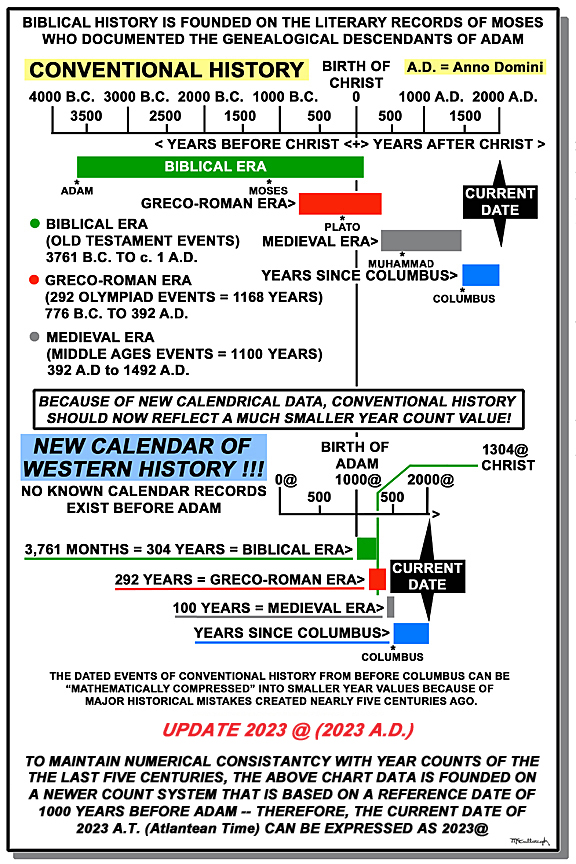
Conventional History and the New Timeline.
It should be realized by historians that all recorded human history prior to the Renaissance was recompiled and "dated" by religious scholars in an age when a new math system was superceeding the Roman count system and the invention of the printing press perpetuated the theories of historians who may have erroneously speculated a timeline outline of important people and events.
47/ Most historians reading this chapter will not accept the idea that our forefathers could be so wrong as to not realize such a huge calendrical error, and that any significant error would have been corrected long before now - however, if they would take the time to review conventional history under this new theoretical annual perspective, they may rediscover just how unique human history truly is.
(The first western coins that give the AD timeline date, either in Roman numerals or in modern numbers, are dated to only about seven centuries ago - so, either placing the year count on coins just became "fashionable" some thirteen centuries after Christ, or the AD dates on coins where "minted" by artist who used "dated" chronological data from other influential scholars)
[As mentioned earlier, it is now believed that because THE NUREMBERG CHRONICLE by Hartmann Schedel was published one year after Columbus discovered the New World -- and because this book project was not destoryed by a Papal Bull order to burn other books some nine years later, perhaps this "chronicle of history" became the offical version of history for other historians to follow when recording ancient history]
48/ Further explanations regarding Old World Governmental History can be found in Appendix 3 of this book.
49/ Let us now return to the calendrical mathematics of the Trans-Atlantean Solar Calendar and discover how this lost time-scale came about -- and why it was forgotten.
50/ In order to rediscover how this antediluvian calendar used a super-leap day formula exactly every 50-years, we should first divide calendrical time into decimal values.
(It should be noted that the word "time" equals the numerical decimal value of "ten", because the diatonic term "ti" (7) plus "mi" (3) equals or add up to "ten" (10))
51/ As mentioned in Volume 2, Chapter 1, of this book project, one Tropical Solar Year amounts to 365.2422 days -- however, because the 24 hour clock of today is designed to have 365 or 366 "twenty-four" hours every "year", some left-over time has to be intercalated in order to account for the fraction of a day left over.
52/ So the question at this point is how did the time-keepers of the Trans-Atlantean Solar Calendar recognize the .2422 "extra" day every 365 days -- and equally important is what mathematical method did they use to "disperse" the extra .2422 day over the years?
53/ The answer to the first question lies in the realization that a .2422 day, or 5.8128 hours, amounts to the solar-time value of 145.32 "solar units" -- in which a "solar unit", or 144 seconds, is the length of time it takes the sun to completely rise or set at the horizon during the equinoxes.
(There exists exactly 600 "solar units" every 24 hours during the equinoxes in the tropical latitudes; 144 seconds -- or 2 minutes and 24 seconds, times 600 equals 24 hours)
[If there is any question as to why the 60 second and 60 minute time values are used today to keep daily time, the answer lies in the 600 "solar unit value" every 24 hours formula]
54/ In other words, an "optical time measuring device" was once used to detect the exact time value of 145.32 solar units, or 5.8128 hours, between the sunset of the Spring Equinox and the helical setting of the "dog" star Sirius after counting 365 days.
(Using the second brightest star in the sky as a "timing light" in comparison to solar light is very unique in time-keeping techniques)
[Not withstanding this incredible technique in measuring the annual time difference between our setting sunlight and the setting starlight of Sirius -- is the amazing coincidence that the amount of time between a ray of light from our sun and a ray of light from the second brightest star in the sky, equals the same percent value of a solar day that can be found in the leap-day formula of the Trans-Atlantean Solar Calendar]

The time between the setting of the sun and the setting of Sirius
on the Spring Equinox equals 5.8128 hours -- or .2422 of a 24 hour day.
Verified by the Astronomical program Stellarium, the .2422 leap-day formula -- used in the Trans-Atlantean Solar Calendar to "balance calendar timekeeping", was discovered long before the Greco-Roman Era. However, the art of simulating star date activity far in the past using any computer program will have "timing issues" -- resulting in some inconsistant data that may not be fully accurate.
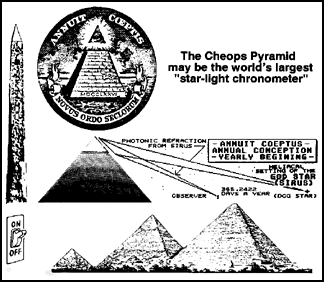
Pyramidal Star Clocks.
56/ So, for every 100 years the .2422 "extra" day would accumulate to the time value of 24.22 "extra" days.
(A .2422 day times 100 equals 24.22 days)
57/ Now because if every 100 years were to be divided by the time value of 4.5 years -- whereby for every alternate fourth and fifth year, an "extra" leap-day was intercalated, the result would amount to 22.22 extra days every 100 years.
58/ Add to this 22.22 extra day formula, one more extra day every 50-years -- or one "super-leap" day, and the total amount would equal 24.22 extra days every 100 years!
59/ Therefore this ingenious lost time formula, barely remembered as the 49-year Judaic "Jubilee", was the super-leap day concept once used by the Atlantean Maritime Kingdom.
(One translation of Plato's Atlantean Dialogues state that the inhabitants of Atlantis were accustomed to assemble in the center of the island continent at the sanctuary "at alternate intervals of four and five years")
60/ The main reason why this calendrical method of counting time was forgotten long ago could have been because of a great world-wide disastrous event that destroyed certain archives wherein this math was kept.
61/ According to a "new scientific understanding" of several mythical and Biblical descriptions about how a large fire-like object in the sky -- followed by rain and earthquakes, destroyed much of the known world, this great disastrous world-wide event was probably the result of a rouge comet reacting with solar energy in a way that caused a large solar flare and a great atmospheric storm!
(The mythical Greek story about Phaethon is probably a personified legend about how the atmosphere of earth was almost destroyed by a solar flare event caused by a rouge comet)
[The Biblical story about the "great flood" may also be seen as a narrative describing how "forty-days and forty-nights" of world-wide rain could have been caused by a rouge comet or a solar flare event]
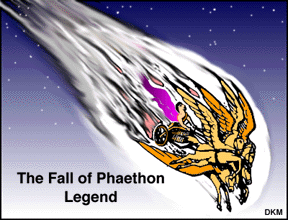
Comet Phaethon destroyed the antediluvian age of Atlantis.
According to Plato: "There is a story....that once upon a time Phaethon, the son of Helios, having yoked the steeds in his father's chariot, because he was not able to drive them in the path of his father, burned up all that was upon the earth, and was himself destroyed by a thunderbolt. Now this has a form of a myth, but really signifies a declination of the bodies moving in the heavens around the earth, and a great conflagration of things upon the earth which recurs after long intervals.
- TIMAEUS Dialogue / 22.c,d